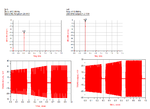LandLack
Member level 3

- Joined
- Aug 8, 2013
- Messages
- 54
- Helped
- 1
- Reputation
- 2
- Reaction score
- 1
- Trophy points
- 8
- Activity points
- 526
Hi, I don't understand something about the amplifiers I'm using during my simulations with ADS; my circuit has a square signal which has been previously upconverted to 410MHz. I need to amplify this signal from -20 dbm to near 0dbm, so I use an amplifier. After the simulation, with "Harmonic Balance" (power amplitude-frequency) I see that the signal has really been amplified by about 18 dB (to -2.1dBm), but when I see the "Transient" result it is displayed that the amplitude of the voltage hasn't changed (it seems to have been decreased from 31mV to 27mV). Shouldn't power be (V^2)/R? Why can't I see a voltage amplification of (about) 10 if the power has been amplified by (about) 100 times?
Since the harmonic balance seems to confirm the datasheet values, I don't think that something in my schematic was wrong. I'm giving you the graphs obtained in an attached image.amplimm.png
Since the harmonic balance seems to confirm the datasheet values, I don't think that something in my schematic was wrong. I'm giving you the graphs obtained in an attached image.amplimm.png


